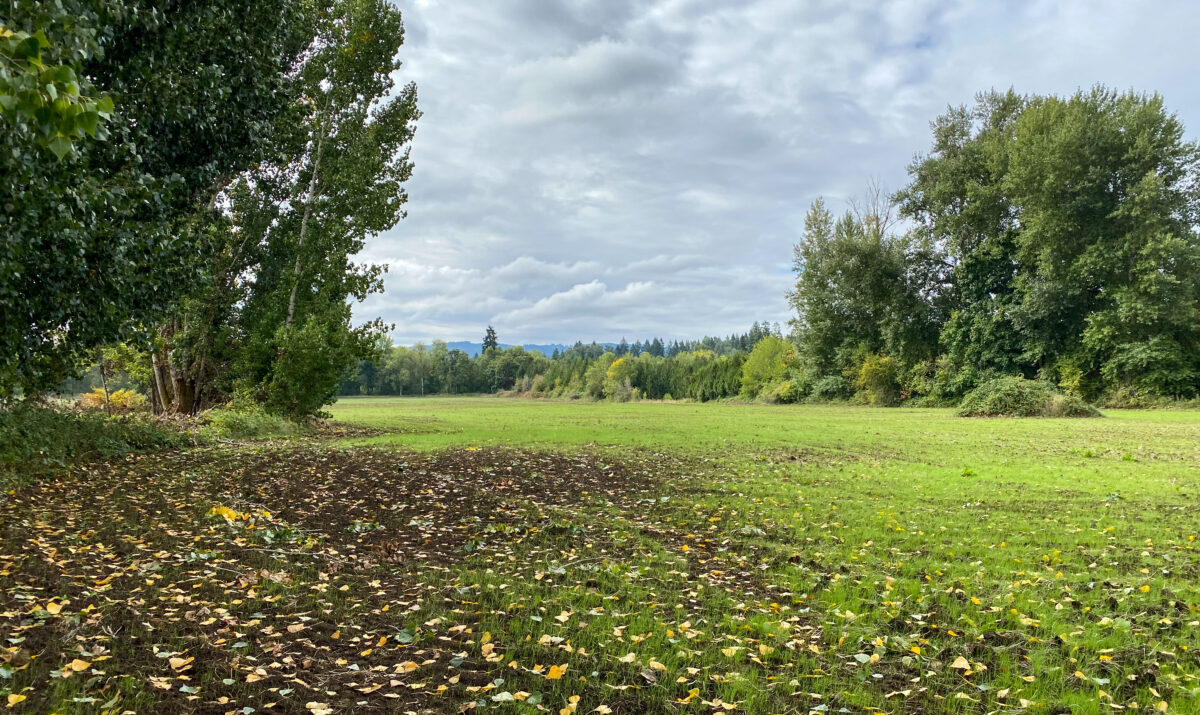Funding Secured for Restoration in Tualatin River Watershed
Oak woodland, savanna, and prairie restoration to kick off in Washington County this Spring

Columbia Land Trust is set to begin a native habitat restoration project in Washington County this year!
Nestled in a crook of the Tualatin River near Scholls, Oregon, Rainbow Natural Area is a 76-acre site offering the opportunity to restore rare Oregon white oak and wetland habitat in the river’s floodplain. Conserved by Columbia Land Trust in 2015, the landscape includes more than a mile of Tualatin River shoreline with 20 acres of native forest along the river, where the Land Trust has already been working to improve habitat. The remainder of the site is a 50-acre field in the floodplain which will be the primary focus of this restoration effort.
When we acquired the site, the field was fallow and overgrown with weeds and pasture grasses. Over the last seven years, the field has been cultivated through a lease arrangement with a local farmer who used the land to grow grain. This strategic collaboration stabilized site conditions and served as an effective weed control measure while Columbia Land Trust prepared to begin restoration.
1Thanks to funding from the Tualatin Soil and Water Conservation District and the Oregon Wildlife Foundation, our team is planning to begin native prairie, oak savanna, and oak woodland restoration on these 50 acres, returning them to a natural state. Work will kick-off this spring and summer with preparing the site for planting through careful soil cultivation and weed control, followed by planting native prairie wildflower bulbs in later summer. Future stages will include seeding a diverse mix of prairie plants and the planting of Oregon white oak (Quercus garryana) trees and other native trees and shrubs.
Oregon white oak woodland, savanna, and wet prairie habitats have become increasingly rare in the Willamette Valley and are crucial to a variety of wildlife. These habitats persisted for thousands of years through the use of fire and other stewardship practices by Indigenous peoples, and are important resources for tribes and Indigenous communities in our region. By restoring native habitats in the floodplain, the project will benefit soil health, reduce erosion risk, help restore natural watershed processes, and improve water quality in the Tualatin River. The 50-acre restoration site will connect with the adjacent 26 acres of riparian forest and river channel where stewardship work is already happening, collectively benefitting salmon and steelhead along with other wildlife, including threatened or declining species like the western meadowlark (Sturnella neglecta), Fender’s blue butterfly (Icaricia icarioides fenderi), and Oregon vesper sparrow (Pooecetes gramineus affinus).
Columbia Land Trust has envisioned the restoration potential of Rainbow Natural Area since our team first set foot on the land. Despite decades of farming, native wetland plants still persist in the wettest parts of the field, and large oak trees and patches of beautiful spring wildflowers can be found in the adjacent forest. “We can’t go back to the past, but we can help native plant communities take hold and thrive again here,” said Emily Matson, Columbia Land Trust Natural Area Manager who will lead the project. “We’re excited to be taking the first steps toward restoring this important and rare habitat.” We look forward to sharing updates with you as the year progresses.
1This restoration project would not be possible without the generous support of local partners, including $100,000 from the Tualatin Soil and Water Conservation District and $10,000 from the Oregon Wildlife Foundation.